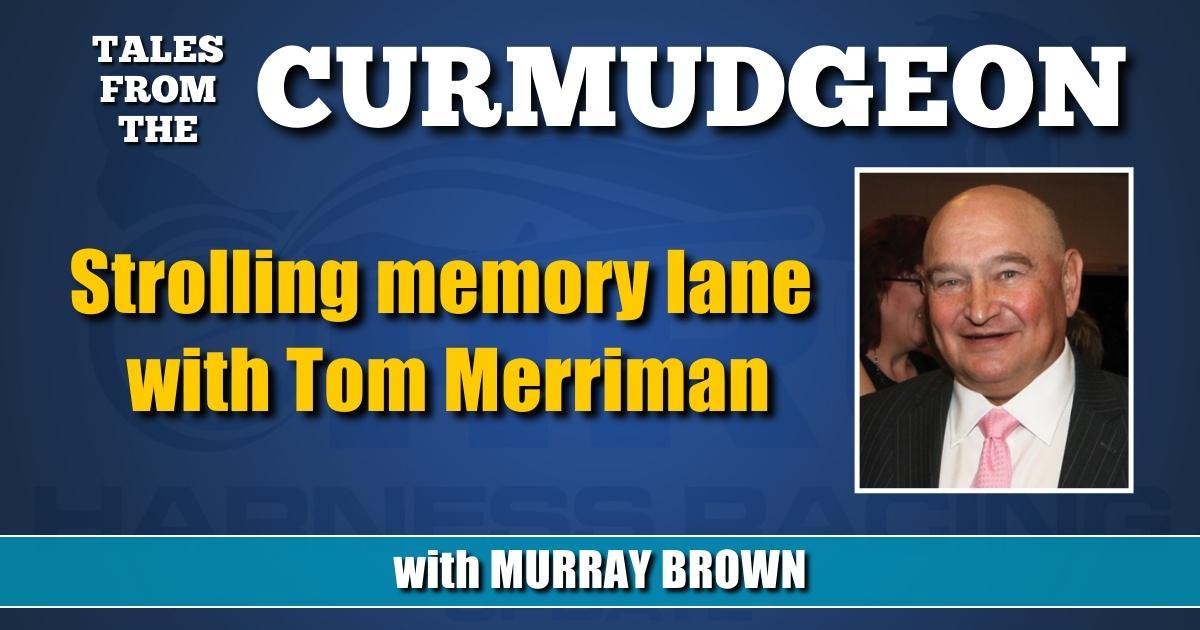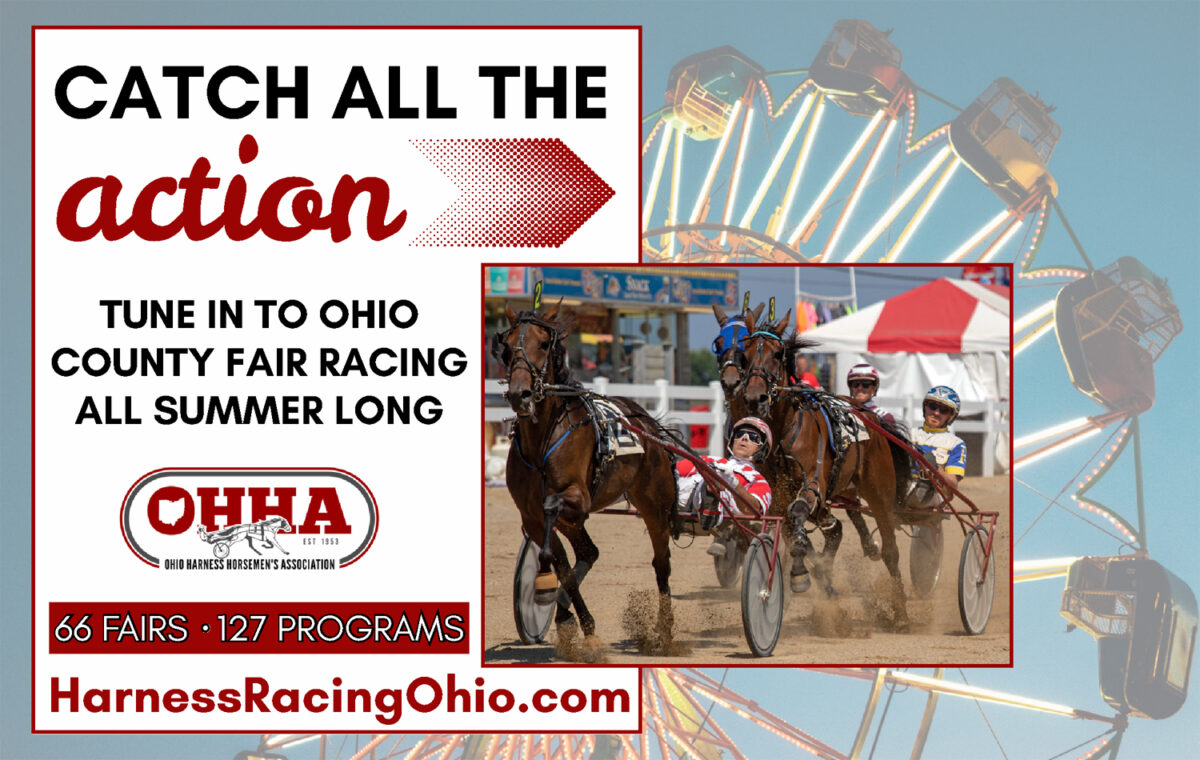Strolling memory lane with Tom Merriman
by Murray Brown
If one were looking for the mythical “Mayor of Sunshine Meadows,” most people might be inclined to name Myron Bell, Sam Bowie or Jerry Glantz. These three are certainly in the running. However this scribe’s vote would go for Tom Merriman. Rare is the day when Tom is not sitting alongside The Deck in his trusty golf cart, stopwatch in hand clocking the horses as they go their miles. He admits that the job is now much more difficult since the horses do not wear numbers which enable them to be easily identified.
Tom has spent every winter since 1998 at what I would now call the Winter Capital of Harness Racing in South Florida.
Where did it all begin and how has it progressed through the years?
“My first drive was at the age of 17 at the Marshall Michigan Fair in 1957. That same year, I also drove at Northville Downs. I stayed in Michigan racing horses at Wolverine and Hazel Park until 1974 when I moved to the so-called big time at Roosevelt and Yonkers.
“Sadly Wolverine, Hazel Park and Roosevelt are now gone and Yonkers is just a shadow of its once mighty self. I was basically working for one man, Robert Kalish, for who I raced for 18 years. While racing at the New York tracks I would occasionally move over to The Meadowlands if I had a horse that was competitive.”
Tell us about those early years at The Meadowlands.
“What else can I say other than it was the place to be. Harness racing never had a better venue. The horses were great, the drivers were the very best and all the best stables raced there. It was there that I raced Energy Burner, likely the very best horse that I’ve had in my stable. He was the New Jersey Sires Stakes champion at 2, 3 and 4 and earned over a million dollars.”
You’ve also raced and trained in Florida for a long time.
“I am among the very few still around who opened Pompano Park. I did quite well there during the track’s formative years. I was the leading trainer there in 1964 and I and Tom Wilburn were the leading drivers there in 1965. We did reasonably well.
“We had a circuit which consisted of Pompano in the winter and the Michigan tracks and subsequently the metropolitan New York tracks during the main racing seasons.
“In 1990, I was at the Harrisburg sale and got to speaking with my friend Doug Ackerman. Doug said that Howard Beissinger was looking for a good American trainer to go to Italy to train the horses owned by the noted clothing designer Roberto Cavalli. Howard had trained the horses that Signor Cavalli raced in the States and was good friends with the clothing impresario. My stable had winded down somewhat. Doug thought that I might be a good man for the job, if I were interested. I talked it over with my wife, Anne. We were soon on our way to Italy. We did pretty well over there, but we soon got homesick and came home after two years.”
You were, in effect, born into the sport.
“Yes indeed. My dad was a horseman. Chris Boring and I were raised together. All I ever knew was horses and horse racing. I suppose if I know something now it all relates to horses. My wife, Anne, is also a horse person. She generally rides for one of the stables at Sunshine Meadows until they ship north. We used to ship north as well as soon as the season was over down here. Anne and I would ship north to The Meadows where we would help out with the Parker stable. From The Meadows we would go to Lexington for the Grand Circuit meeting and then start the cycle anew.”
You gave up your stable in 1998.
“Fred Monteleone offered me a job as his contract trainer and Anne and I went to work for him. We were with Fred for five years. We did pretty well. We had some pretty good horses from a relatively small number that we trained including Civil Action ($1,123,053), Monte Hall ($834,513) and Cincinnati Kid ($744,606).”
You’ve worked for and with some Hall of Famers and perhaps a future Hall of Famer in Tony Alagna.
“Starting out, the first Hall of Famer I worked for was Dick Buxton. When I was with Dick he put me up to drive his world champion trotter Senator Frost. The horse wasn’t quite what he had been, but I still considered it to be a great honor to sit behind him. I worked for Chuck Sylvester when he had Mack Lobell as a 2-year-old. He was a wonderful colt pretty much from the beginning. His great feats were monumental, but they didn’t surprise me at all. The last person I worked for was Tony Alagna. What a great operation that is. They’ve got a whole lot of horses, but the operation runs like clockwork. I had to give up riding because of troubles with my back. Nowadays I don’t ride but Anne still does.”
You’ve mentioned Mack Lobell as being great from the beginning and he turned out to be everything one might hope for. Have you ever had one that you thought was going to be great but didn’t turn out as well as you thought?
“I had this Cam Fella filly that I thought the world of. Training down, she was more than impressive. However, when she hit 1:57, she decided that was as fast as she would go. I put Mike Lachance up thinking that maybe he would wake her up. She still hit that brick wall at 1:57. But that’s not the end of the story. Her name was Where’s Sarah. She is the second dam of the great Somebeachsomewhere. I suppose the speed that I thought she had was there, but it was, in fact, hiding. It just took a couple of generations for it to come out.”
You’ve been around for several generations. Tell us the main differences you’ve seen.
“The biggest difference is in the horses themselves and the way we train them. Today’s horse is physically more akin to the thoroughbreds. For lack of a better term, I’ll say that they are more streamlined. They are bred for speed while many of the horses of yesteryear were bred for stamina. I think that a lot of our horses now couldn’t take the intense training we used to give them. It was the norm back then to go three heats with a horse. Now many only go one. Today’s horse is also better conformed. As yearlings at the sales, they exhibit fewer physical faults. It used to be that they would be coarse boned often having blemishes such as curby hocks. It’s rare that we see that today.”
Who are the best horses you’ve seen through the years?
“It’s generational, but through the years with pacers, the first great one I think of is Adios Butler. He was followed by Bret Hanover, Cardigan Bay, Albatross and more recently Somebeachsomewhere.
“With trotters I think it’s more varied probably due to the European influence. Among them were my emotional pick Senator Frost [plus] Su Mac Lad, Nevele Pride, Speedy Crown and Super Bowl. Then you need to add the great French trotters who’s dominance in International racing began with Jamin.”
How about drivers?
“The drivers of today are much like the horses. They are more streamlined. You aren’t going to see too many good drivers built like Frank Safford and Clint Hodgins. They are in the best of shape and don’t weigh much. What they can do is make horses go fast and they do. It used to be, in most races, you’d maybe have a few who I would consider to be ‘professional’ drivers, with the rest being trainer/drivers who were not. You can go to most racetracks today and find that there is not that much difference between drivers one to eight. It’s mostly up to the horse.
Any final thoughts?
“Two of our Hall of Fame brethren, Chris Boring and Chuck Sylvester, lost their wives in the last few days. How ironic is it that two great Hall of Fame horsemen, who basically started in the game together and were lifelong friends, would suffer such heartbreaking loss within a matter of a few days.
“My sincerest condolences to the Boring and Sylvester families.”
Have a question or comment for The Curmudgeon? Reach him by email at: hofmurray@aol.com

















